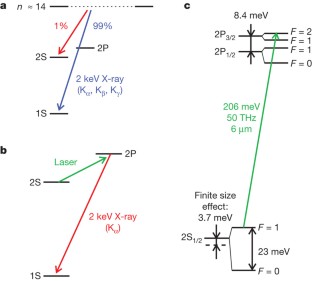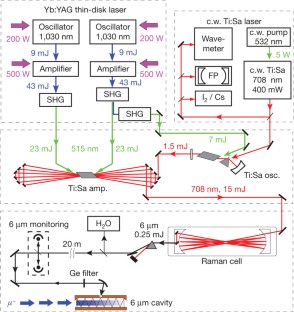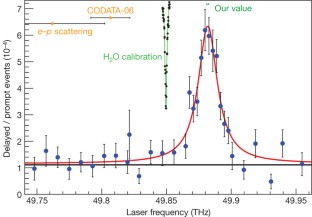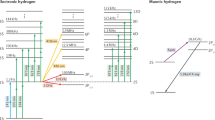Abstract
The proton is the primary building block of the visible Universe, but many of its properties—such as its charge radius and its anomalous magnetic moment—are not well understood. The root-mean-square charge radius, rp, has been determined with an accuracy of 2 per cent (at best) by electron–proton scattering experiments1,2. The present most accurate value of rp (with an uncertainty of 1 per cent) is given by the CODATA compilation of physical constants3. This value is based mainly on precision spectroscopy of atomic hydrogen4,5,6,7 and calculations of bound-state quantum electrodynamics (QED; refs 8, 9). The accuracy of rp as deduced from electron–proton scattering limits the testing of bound-state QED in atomic hydrogen as well as the determination of the Rydberg constant (currently the most accurately measured fundamental physical constant3). An attractive means to improve the accuracy in the measurement of rp is provided by muonic hydrogen (a proton orbited by a negative muon); its much smaller Bohr radius compared to ordinary atomic hydrogen causes enhancement of effects related to the finite size of the proton. In particular, the Lamb shift10 (the energy difference between the 2S1/2 and 2P1/2 states) is affected by as much as 2 per cent. Here we use pulsed laser spectroscopy to measure a muonic Lamb shift of 49,881.88(76) GHz. On the basis of present calculations11,12,13,14,15 of fine and hyperfine splittings and QED terms, we find rp = 0.84184(67) fm, which differs by 5.0 standard deviations from the CODATA value3 of 0.8768(69) fm. Our result implies that either the Rydberg constant has to be shifted by −110 kHz/c (4.9 standard deviations), or the calculations of the QED effects in atomic hydrogen or muonic hydrogen atoms are insufficient.
This is a preview of subscription content, access via your institution
Access options
Subscribe to this journal
Receive 51 print issues and online access
185,98 € per year
only 3,65 € per issue
Buy this article
- Purchase on SpringerLink
- Instant access to full article PDF
Prices may be subject to local taxes which are calculated during checkout





Similar content being viewed by others
References
Sick, I. On the rms-radius of the proton. Phys. Lett. B 576, 62–67 (2003)
Blunden, P. G. & Sick, I. Proton radii and two-photon exchange. Phys. Rev. C 72, 057601 (2005)
Mohr, P. J., Taylor, B. N. & Newell, D. B. CODATA recommended values of the fundamental physical constants: 2006. Rev. Mod. Phys. 80, 633–730 (2008)
Niering, M. et al. Measurement of the hydrogen 1S - 2S transition frequency by phase coherent comparison with a microwave cesium fountain clock. Phys. Rev. Lett. 84, 5496–5499 (2000)
Fischer, M. et al. New limits on the drift of fundamental constants from laboratory measurements. Phys. Rev. Lett. 92, 230802 (2004)
de Beauvoir, B. et al. Metrology of the hydrogen and deuterium atoms: determination of the Rydberg constant and Lamb shifts. Eur. Phys. J. D 12, 61–93 (2000)
Schwob, C. et al. Optical frequency measurement of the 2S – 12D transitions in hydrogen and deuterium: Rydberg constant and Lamb shift determinations. Phys. Rev. Lett. 82, 4960–4963 (1999)
Eides, M. I., Grotch, H. & Shelyuto, V. A. Theory of light hydrogenlike atoms. Phys. Rep. 342, 63–261 (2001)
Karshenboim, S. G. Precision physics of simple atoms: QED tests, nuclear structure and fundamental constants. Phys. Rep. 422, 1–63 (2005)
Lamb, W. E. & Retherford, R. C. Fine structure of the hydrogen atom by a microwave method. Phys. Rev. 72, 241–243 (1947)
Pachucki, K. Theory of the Lamb shift in muonic hydrogen. Phys. Rev. A 53, 2092–2100 (1996)
Pachucki, K. Proton structure effects in muonic hydrogen. Phys. Rev. A 60, 3593–3598 (1999)
Borie, E. Lamb shift in muonic hydrogen. Phys. Rev. A 71, 032508 (2005)
Martynenko, A. P. 2S Hyperfine splitting of muonic hydrogen. Phys. Rev. A 71, 022506 (2005)
Martynenko, A. P. Fine and hyperfine structure of P-wave levels in muonic hydrogen. Phys. At. Nucl. 71, 125–135 (2008)
Pachucki, K. & Jentschura, U. D. Two-loop Bethe-logarithm correction in hydrogenlike atoms. Phys. Rev. Lett. 91, 113005 (2003)
Antognini, A. et al. The 2S Lamb shift in muonic hydrogen and the proton rms charge radius. AIP Conf. Proc. 796, 253–259 (2005)
Jensen, T. S. & Markushin, V. E. Collisional deexcitation of exotic hydrogen atoms in highly excited states. Eur. Phys. J. D 21, 261–270 (2002)
Pohl, R. 2S state and Lamb shift in muonic hydrogen. Hyp. Interact. 193, 115–120 (2009)
Pohl, R. et al. Observation of long-lived muonic hydrogen in the 2S state. Phys. Rev. Lett. 97, 193402 (2006)
Pohl, R. et al. The muonic hydrogen Lamb-shift experiment. Can. J. Phys. 83, 339–349 (2005)
Antognini, A. et al. Thin-disk Yb:YAG oscillator-amplifier laser, ASE, and effective Yb:YAG lifetime. IEEE J. Quantum Electron. 45, 993–1005 (2009)
Giesen, A. et al. Scalable concept for diode-pumped high-power solid-state lasers. Appl. Phys. B 58, 365–372 (1994)
Antognini, A. et al. Powerful fast triggerable 6 µm laser for the muonic hydrogen 2S-Lamb shift experiment. Opt. Commun. 253, 362–374 (2005)
Nebel, T. et al. Status of the muonic hydrogen Lamb-shift experiment. Can. J. Phys. 85, 469–478 (2007)
Rabinowitz, P., Perry, B. & Levinos, N. A continuously tunable sequential Stokes Raman laser. IEEE J. Quantum Electron. 22, 797–802 (1986)
Ludhova, L. et al. Planar LAAPDs: temperature dependence, performance, and application in low-energy x-ray spectroscopy. Nucl. Instrum. Methods A 540, 169–179 (2005)
Toth, R. A. Water vapor measurements between 590 and 2582 cm−1: Line positions and strengths. J. Mol. Spectrosc. 190, 379–396 (1998)
Rothman, L. S. et al. The HITRAN 2008 molecular spectroscopic database. J. Quant. Spectrosc. Radiat. Transf. 110, 533–572 (2009)
Kilic, S., Karr, J.-P. & Hilico, L. Coulombic and radiative decay rates of the resonances of the exotic molecular ions ppµ, ppπ, ddµ, ddπ, and dtµ. Phys. Rev. A 70, 042506 (2004)
Lundeen, S. R. & Pipkin, F. M. Measurement of the Lamb shift in hydrogen, n = 2. Phys. Rev. Lett. 46, 232–235 (1981)
Belushkin, M. A., Hammer, H.-W. & Meissner, U.-G. Dispersion analysis of the nucleon form factors including meson continua. Phys. Rev. C 75, 035202 (2007)
Hanneke, D., Fogwell, S. & Gabrielse, G. New measurement of the electron magnetic moment and the fine structure constant. Phys. Rev. Lett. 100, 120801 (2008)
Acknowledgements
We thank L. Simons and B. Leoni for setting up the cyclotron trap, H. Brückner, K. Linner, W. Simon, O. Huot and Z. Hochman for technical support, P. Maier-Komor, K. Nacke, M. Horisberger, A. Weber, L. Meier and J. Hehner for thin foils and windows, N. Schlumpf, U. Hartmann and M. Gaspar for electronics, S. Spielmann-Jaeggi and L. Carroll for optical measurements, Ch. Parthey and M. Herrmann for their help, the MEG-collaboration for a share of beam-time, and A. Voss, B. Weichelt and J. Fruechtenicht for the loan of a laser pump diode. We acknowledge the essential contributions of H. Hofer and V.W. Hughes in the initial stages of the experiment. We also thank the PSI accelerator division, the Hallendienst, the workshops at PSI, MPQ and Fribourg, and other support groups for their help. We acknowledge support from the Max Planck Society and the Max Planck Foundation, the Swiss National Science Foundation (project 200020-100632) and the Swiss Academy of Engineering Sciences, the BQR de l'UFR de physique fondamentale et appliquée de l'Université Paris 6, the program PAI Germaine de Staël no. 07819NH du ministère des affaires étrangères France, and the Fundação para a Ciência e a Tecnologia (Portugal) and FEDER (project PTDC/FIS/82006/2006 and grant SFRH/BPD/46611/2008). P.I. and E.-O.L.B. acknowledge support from the ‘ExtreMe Matter Institute, Helmholtz Alliance HA216/EMMI’.
Author information
Authors and Affiliations
Contributions
R.P., A.A., F.N., F.D.A., F.B., A.D., A.G., T.G., T.W.H., L.J., C.-Y.K., Y.-W.L., T.N., P.R., K.S., C.S. and F.K. designed, built and operated parts of the laser system. R.P., A.A., F.N., D.S.C., L.M.P.F., P.K., Y.-W.L., J.A.M.L., L.L., C.M.B.M., F.M., T.N., J.M.F.d.S., L.A.S., K.S., D.T., J.F.C.A.V. and F.K. planned, built and set up the various detectors of the experiment. R.P., A.A., D.S.C., F.M., D.T., J.F.C.A.V. and F.K. designed, built, set up and operated the muon beam line. R.P., A.A., F.N., J.M.R.C., D.S.C., A.D., S.D., L.M.P.F., C.-Y.K., P.K., Y.-W.L., F.M., T.N., J.M.F.d.S., K.S., D.T., J.F.C.A.V. and F.K. designed and implemented the electronics used in the experiment. R.P., A.A., J.M.R.C., P.I., P.K., E.-O.L.B. and T.N. set up the computing infrastructure, wrote software and realized the data acquisition system. R.P., A.A., F.N., F.D.A. F.B., J.M.R.C., D.S.C., A.D., L.M.P.F., P.I., L.J., C.-Y.K., P.K., E.-O.L.B., Y.-W.L., J.A.M.L., L.L., C.M.B.M., F.M., T.N., J.M.F.d.S., K.S., C.S., D.T., J.F.C.A.V. and F.K. took part in the months-long data-taking runs. E.-O.L.B., P.I. and F.K. did work on QED theory. R.P., A.A., F.N., F.B., P.I., L.J., P.K., L.L., T.N., D.T. and F.K. analysed the data and wrote the initial manuscript. The manuscript was then read, improved and finally approved by all authors.
Corresponding author
Ethics declarations
Competing interests
The authors declare no competing financial interests.
Supplementary information
Supplementary Information
This file contains Supplementary Data, References and Supplementary Tables 1-2. (PDF 92 kb)
Rights and permissions
About this article
Cite this article
Pohl, R., Antognini, A., Nez, F. et al. The size of the proton. Nature 466, 213–216 (2010). https://doi.org/10.1038/nature09250
Received:
Accepted:
Issue Date:
DOI: https://doi.org/10.1038/nature09250
This article is cited by
-
Design of a microwave spectrometer for high-precision lamb shift spectroscopy of antihydrogen atoms
Interactions (2024)
-
Rabi-oscillation spectroscopy of the hyperfine structure of the muonium atom for high-precision determination of the muon mass
Interactions (2024)
-
Recent Results on Proton Charge Radius and Polarizabilities
Few-Body Systems (2024)
-
Data-Driven Extraction of Hadron Radii
Few-Body Systems (2023)
-
Chiral perturbation theory: reflections on effective theories of the standard model
Indian Journal of Physics (2023)



